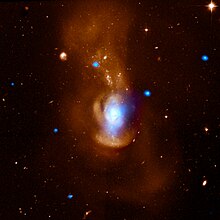NGC 4194
| NGC 4194 | |
|---|---|
 | |
| Observation data (J2000 epoch) | |
| Constellation | Ursa Major |
| Right ascension | 12h 14m 09.64s[1] |
| Declination | +54° 31′ 34.60″[1] |
| Redshift | 0.008433[2] |
| Heliocentric radial velocity | 2,511±12 km/s[3] |
| Distance | 128 Mly (39.1 Mpc)[4] |
| Apparent magnitude (V) | 13.30[5] |
| Apparent magnitude (B) | 13.79[5] |
| Characteristics | |
| Type | Imeger[2] |
| Apparent size (V) | 0.14′ × 0.13′[6] |
| Notable features | Interacting, starburst |
| Other designations | |
| Medusa galaxy merger, NGC 4194, Arp 160, UGC 7241, Mrk 201, PGC 39068[7] | |
NGC 4194, the Medusa merger, is a galaxy merger in the constellation Ursa Major about 128 million light-years (39.1 Mpc) away.[4] It was discovered on April 2, 1791 by German-British astronomer William Herschel.[8] Due to its disturbed appearance, it is object 160 in Halton Arp's 1966 Atlas of Peculiar Galaxies.[7]

The morphological classification of NGC 4194 is Imeger,[2] indicating an irregular form. This galaxy consists of a brighter central region spanning an angular size 9″ across, with an accompanying system of loops and arcs. Additional material is thinly spread out to a radius of 75″ from the central region.[9] There is a tidal tail and regions undergoing high levels of star formation, making this a starburst galaxy. It is a source for strong infrared and radio emission.[10][11] These features indicate NGC 4194 is a late-stage galaxy merger.[12] A region of extreme star formation 500 ly (150 pc) across exists in the center of the Eye of Medusa, the central gas-rich region.[13]
Within 1.2 kpc (3.9 kly) of the dynamic center of NGC 4194, star formation is occurring at a rate of 8 M☉·yr−1. The star forming regions in this volume range from 5 to 9 million years in age, with the youngest occurring in areas of the highest star formation rate.[14] As of 2014, no galactic nucleus has been detected based on radio emissions, nor have the respective nuclei of the merger galaxies.[15] However, X-ray emission from a black hole in the tidal tail was detected by Chandra in 2009.[16]
References
[edit]- ^ a b Samsonyan, Anahit; et al. (September 2016). "Neon and [C II] 158 μm Emission Line Profiles in Dusty Starbursts and Active Galactic Nuclei". The Astrophysical Journal Supplement Series. 226 (1). id. 11. arXiv:1608.02277. Bibcode:2016ApJS..226...11S. doi:10.3847/0067-0049/226/1/11.
- ^ a b c Ann, H. B.; et al. (2015). "A Catalog of Visually Classified Galaxies in the Local (z ~ 0.01) Universe". The Astrophysical Journal Supplement Series. 217 (2): 27–49. arXiv:1502.03545. Bibcode:2015ApJS..217...27A. doi:10.1088/0067-0049/217/2/27. S2CID 119253507.
- ^ Falco, Emilio E.; et al. (April 1999). "The Updated Zwicky Catalog (UZC)". Publications of the Astronomical Society of the Pacific. 111 (758): 438. arXiv:astro-ph/9904265. Bibcode:1999PASP..111..438F. doi:10.1086/316343. S2CID 14298026.
- ^ a b Lianou, S.; et al. (November 2019). "Dust properties and star formation of approximately a thousand local galaxies". Astronomy & Astrophysics. 631: 19. arXiv:1906.02712. Bibcode:2019A&A...631A..38L. doi:10.1051/0004-6361/201834553. S2CID 174801441. A38.
- ^ a b Véron-Cetty, M.-P.; Véron, P. (2010). "A catalogue of quasars and active nuclei: 13th edition". Astronomy & Astrophysics. 518 (A10): A10. Bibcode:2010A&A...518A..10V. doi:10.1051/0004-6361/201014188.
- ^ "Results for NGC 4194". NASA/IPAC Extragalactic Database. Jet Propulsion Laboratory, California Institute of Technology, under contract with the National Aeronautics and Space Administration. January 12, 2007. Retrieved 2024-03-24.
- ^ a b "NGC 4194". SIMBAD. Centre de données astronomiques de Strasbourg. Retrieved 2024-03-24.
- ^ Seligman, Courtney. "NGC Objects: NGC 4150 - 4199". Celestial Atlas. Retrieved 2024-04-01.
- ^ Demoulin, Marie-Helene (April 1969). "The Peculiar Galaxy NGC 4194". Astrophysical Journal. 156: 325. Bibcode:1969ApJ...156..325D. doi:10.1086/149967.
- ^ Weistrop, D.; et al. (March 2004). "Looking Closely at Medusa: Star-forming Knots at the Center of NGC 4194". The Astronomical Journal. 127 (3): 1360–1370. Bibcode:2004AJ....127.1360W. doi:10.1086/382092.
- ^ Hancock, M.; et al. (December 2003). "A Spectroscopic Study of the Star-Forming Properties of the Center of NGC 4194". The Astronomical Journal. 131 (1): 1394. Bibcode:2003AAS...20311515H. doi:10.1086/497969.
- ^ Joseph, R. D.; Wright, G. S. (May 1985). "Recent star formation in interacting galaxies - II. Super starbursts in merging galaxies". Monthly Notices of the Royal Astronomical Society. 214 (2): 87–95. Bibcode:1985MNRAS.214...87J. doi:10.1093/mnras/214.2.87.
- ^ "Unknown extreme star formation discovered". Space Daily. 17 June 2015. Retrieved 2024-03-24.
- ^ Weistrop, D.; et al. (April 2012). "Characteristics of Star-forming Regions in the Advanced Minor-merger, Luminous Infrared Galaxy NGC 4194". The Astronomical Journal. 143 (4). id. 98. Bibcode:2012AJ....143...98W. doi:10.1088/0004-6256/143/4/98.
- ^ Beck, Sara C.; et al. (May 2014). "Ionized Gas Kinematics at High Resolution. IV. Star Formation and a Rotating Core in the Medusa (NGC 4194)". The Astrophysical Journal. 787 (1). id. 85. arXiv:1404.1562. Bibcode:2014ApJ...787...85B. doi:10.1088/0004-637X/787/1/85.
- ^ "NGC 4194: A Black Hole in Medusa's Hair". Chandra Photo Album. March 11, 2009. Retrieved 2024-04-01.
Further reading
[edit]- König, S.; et al. (July 2018). "Major impact from a minor merger. The extraordinary hot molecular gas flow in the Eye of the NGC 4194 Medusa galaxy". Astronomy & Astrophysics. 615. id. A122. arXiv:1712.04030. Bibcode:2018A&A...615A.122K. doi:10.1051/0004-6361/201732436.
((cite journal)): CS1 maint: multiple names: authors list (link) - Aalto, S.; et al. (November 2010). "13CO 1-0 imaging of the Medusa merger, NGC 4194. Large scale variations in molecular cloud properties". Astronomy and Astrophysics. 522. id.A59. arXiv:1008.2095. Bibcode:2010A&A...522A..59A. doi:10.1051/0004-6361/200913511.
- Kaaret, Philip; Alonso-Herrero, Almudena (August 2008). "X-Ray Sources in the Star-Forming Galaxies NGC 4194 and NGC 7541". The Astrophysical Journal. 682 (2): 1020–1028. arXiv:0805.0683. Bibcode:2008ApJ...682.1020K. doi:10.1086/589764.
External links
[edit]- NGC 4194 on WikiSky: DSS2, SDSS, GALEX, IRAS, Hydrogen α, X-Ray, Astrophoto, Sky Map, Articles and images
Text is available under the CC BY-SA 4.0 license; additional terms may apply.
Images, videos and audio are available under their respective licenses.
